Decreased Visual Search Behavior in Elderly Drivers during the Early Phase of Reverse Parking, But an Increase during the Late Phase
Abstract
:1. Introduction
- Although the importance of visuospatial information processing in road driving is widely recognized, there is limited evidence during reverse parking. It is still unknown whether visuospatial information processing is presented during parking and how it contributes to backward maneuvering.
- It has already been reported that elderly drivers have less visual search behavior [23,24], and this decreased behavior is related to the risk of accidents during backward maneuvering [25]. The risk directly or indirectly leads to driving cessation and decreased out-of-home activity levels [26]. However, the contribution of visual search behavior in reverse parking to parking performance as well as quality of life (QOL) in elderly drivers has not been adequately discussed.
- To identify the visual search behavior characteristics of elderly drivers during reverse parking and compare these characteristics between elderly and expert drivers.
- To clarify how the characteristics of visual search behavior in reverse parking contribute to parking performance as well as QOL in elderly drivers.
2. Materials and Methods
2.1. Participants
2.2. Reverse Perpendicular Parking Task
2.3. Eye-Tracking System
2.4. Conventional Tests
2.5. Statistical Analysis
3. Results
4. Discussion
5. Conclusions
- Elderly drivers had a shorter time of gaze at the vertex of the parking space both in direct vision and reflected in the driver-side mirror during the early phases, resulting in poor parking performance. On the other hand, they increased their gaze time in the passenger-side mirror in the late phase, implying that a compensatory strategy was used to counterbalance the insufficient visual scanning in the previous phases.
- The lower total gaze time in the late phase is related to QOL. This observation could improve our understanding of the characteristics of visual search behavior in parking performance and how this behavior is related to QOL in elderly drivers.
Author Contributions
Funding
Institutional Review Board Statement
Informed Consent Statement
Data Availability Statement
Conflicts of Interest
References
- Abdelfatah, A.S.; Taha, M.A. Parking capacity optimization using linear programming. J. Traffic Transp. Eng. 2014, 2, 176–181. [Google Scholar] [CrossRef]
- American Automobile Association. Available online: https://www.ace.aaa.com/automotive/advocacy/parking-lot-collisions.html (accessed on 25 October 2023).
- Matsui, Y.; Oikawa, S. Gazing Characteristics of a Driver during Vehicle Backing. Appl. Sci. 2021, 11, 2180. [Google Scholar] [CrossRef]
- Takahashi, A. Sequence of Visual Behavior during Parking. In Proceedings of the International Conference on Human-Computer Interaction (HCI International 2013), Las Vegas, NV, USA, 21–26 July 2013; pp. 342–346. [Google Scholar] [CrossRef]
- Douissembekov, E.; Michael, G.A.; Rogé, J.; Bonhoure, P.; Gabaude, C.; Navarro, J. Effects of shrinkage of the visual field through ageing on parking performance: A parametric manipulation of salience and relevance of contextual components. Ergonomics 2015, 58, 698–711. [Google Scholar] [CrossRef]
- Burg, A. Vision and Driving: A Report on Research. Hum. Factors 1971, 13, 79–87. [Google Scholar] [CrossRef] [PubMed]
- Evans, D.W.; Ginsburg, A.P. Contrast Sensitivity Predicts Age-Related Differences in Highway-Sign Discriminability. Hum. Factors 1985, 27, 637–642. [Google Scholar] [CrossRef] [PubMed]
- Tinella, L.; Lopez, A.; Caffò, A.O.; Nardulli, F.; Grattagliano, I.; Bosco, A. Cognitive Efficiency and Fitness-to-Drive along the Lifespan: The Mediation Effect of Visuospatial Transformations. Brain Sci. 2021, 11, 1028. [Google Scholar] [CrossRef]
- Moeller, B.; Zoppke, H.; Frings, C. What a car does to your perception: Distance evaluations differ from within and outside of a car. Psychon. Bull. Rev. 2016, 23, 781–788. [Google Scholar] [CrossRef]
- Galli, G.; Noel, J.P.; Canzoneri, E.; Blanke, O.; Serino, A. The wheelchair as a full-body tool extending the peripersonal space. Front. Psychol. 2015, 1, 639–650. [Google Scholar] [CrossRef] [PubMed]
- Kaller, C.P.; Rahm, B.; Bolkenius, K.; Unterrainer, J.M. Eye movements and visuospatial problem solving: Identifying separable phases of complex cognition. Psychophysiology 2009, 46, 818–830. [Google Scholar] [CrossRef]
- Lappi, O. Future path and tangent point models in the visual control of locomotion in curve driving. J. Vis. 2014, 14, 21. [Google Scholar] [CrossRef]
- Lappi, O.; Pekkanen, J.; Rinkkala, P.; Tuhkanen, S.; Tuononen, A.; Virtanen, J.P. Humans use Optokinetic Eye Movements to Track Waypoints for Steering. Sci. Rep. 2020, 10, 4175. [Google Scholar] [CrossRef]
- Wann, J.P.; Swapp, D.K. Why you should look where you are going. Nat. Neurosci. 2000, 3, 647–648. [Google Scholar] [CrossRef]
- Land, M.F.; Lee, D.N. Where we look when we steer. Nature 1994, 369, 6483. [Google Scholar] [CrossRef]
- Lappi, O.; Rinkkala, P.; Pekkanen, J. Systematic observation of an expert driver’s gaze strategy-an on-road case study. Front. Psychol. 2017, 8, 620. [Google Scholar] [CrossRef]
- Kandil, F.I.; Rotter, A.; Lappe, M. Driving is smoother and more stable when using the tangent point. J. Vis. 2009, 9, 11. [Google Scholar] [CrossRef]
- Land, M.F.; Tatler, B.W. Steering with the head: The visual strategy of a racing driver. Curr. Biol. 2001, 11, 1215–1220. [Google Scholar] [CrossRef]
- Kandil, F.I.; Rotter, A.; Lappe, M. Car drivers attend to different gaze targets when negotiating closed vs. open bends. J. Vis. 2010, 10, 24. [Google Scholar] [CrossRef] [PubMed]
- Sun, Q.C.; Xia, J.C.; He, J.; Foster, J.; Falkmer, T.; Lee, H. Towards unpacking older drivers’ visual-motor coordination: A gaze-based integrated driving assessment. Accid. Anal. Prev. 2018, 113, 85–96. [Google Scholar] [CrossRef]
- Wilson, M.; Stephenson, S.; Chattington, M.; Marple-Horvat, D.E. Eye movements coordinated with steering benefit performance even when vision is denied. Exp. Brain Res. 2007, 176, 397–412. [Google Scholar] [CrossRef] [PubMed]
- Marple-Horvat, D.E.; Chattington, M.; Anglesea, M.; Ashford, D.G.; Wilson, M.; Keil, D. Prevention of coordinated eye movements and steering impairs driving performance. Exp. Brain Res. 2005, 163, 411–420. [Google Scholar] [CrossRef] [PubMed]
- Lavallière, M.; Teasdale, N.; Tremblay, M.; Ngân, N.; Simoneau, M.; Laurendeau, D. Visual inspections made by young and elderly drivers before lane changing. Adv. Transp. Stud. 2007, 17–24. [Google Scholar]
- Romoser, M.R.; Pollatsek, A.; Fisher, D.L.; Williams, C.C. Comparing the glance patterns of older versus younger experienced drivers: Scanning for hazards while approaching and entering the intersection. Transp. Res. Part F Traffic Psychol. Behav. 2013, 16, 104–116. [Google Scholar] [CrossRef] [PubMed]
- Ryan, G.A.; Legge, M.; Rosman, D. Age related changes in drivers’ crash risk and crash type. Accid Anal Prev. 1998, 30, 379–387. [Google Scholar] [CrossRef] [PubMed]
- Marottoli, R.A.; de Leon, C.F.M.; Glass, T.A.; Williams, C.S.; Cooney, L.M., Jr.; Berkman, L.F. Consequences of driving cessation: Decreased out-of-home activity levels. J. Gerontol. B Psychol. Sci. Soc. Sci. 2000, 55, S334–S340. [Google Scholar] [CrossRef]
- Wang, C.; Easa, S.M.; Chen, F.; Cheng, J. Difference in perception-reaction time of plain and plateau drivers at expressway exit ramps. Transp. Res. Part F Traffic Psychol. Behav. 2023, 98, 318–336. [Google Scholar] [CrossRef]
- Ahmadi, N.; Katrahmani, A.; Romoser, M.R. Short and Long-term Transfer of Training in a Tablet-based Teen Driver Hazard Perception Training Program. Proc. Hum. Factors Ergon. Soc. 2018, 62, 1965–1969. [Google Scholar] [CrossRef]
- Takahiro, T.; Kazuhiro, F.; Takashi, Y.; Makoto, I.; Fumiya, K.; Hirofumi, A.; Hitoshi, K. Effect of Difference in Form of Driving Support Agent to Driver’s Acceptability—Driver Agent for Encouraging Safe Driving Behavior (2). J. Transp. Technol. 2018, 8, 194. [Google Scholar] [CrossRef]
- Takahiro, T.; Kazuhiro, F.; Yuki, Y.; Nihan, K.; Hirofumi, A.; Hitoshi, K. Preliminary Study for Feasibility of Driver Agent in Actual Car Environment—Driver Agent for Encouraging Safe Driving Behavior (3). J. Transp. Technol. 2020, 10, 128. [Google Scholar] [CrossRef]
- Baldisserotto, F.; Krejtz, K.; Krejtz, I. A Review of Eye Tracking in Advanced Driver Assistance Systems: An Adaptive Multi-Modal Eye Tracking Interface Solution. In Proceedings of the 2023 Symposium on Eye Tracking Research and Applications, Tubingen, Germany, 30 May–2 June 2023; pp. 1–3. [Google Scholar]
- Acerra, E.M.; Lantieri, C.; Vignali, V.; Pazzini, M.; Andrea, S. Safety roads: The analysis of driving behaviour and the effects on the infrastructural design. Transp. Res. Procedia 2023, 69, 336–343. [Google Scholar] [CrossRef]
- Vos, J.; de Winter, J.; Farah, H.; Hagenzieker, M. Which visual cues do drivers use to anticipate and slow down in freeway curve approach? An eye-tracking, think-aloud on-road study. Transp. Res. Part F Traffic Psychol. Behav. 2023, 94, 190–211. [Google Scholar] [CrossRef]
- Broadbent, D.P.; D’Innocenzo, G.; Ellmers, T.J.; Parsler, J.; Szameitat, A.J.; Bishop, D.T. Cognitive load, working memory capacity and driving performance: A preliminary fNIRS and eye tracking study. Transp. Res. Part F Traffic Psychol. Behav. 2023, 92, 121–132. [Google Scholar] [CrossRef]
- Orsini, F.; Giusti, G.; Zarantonello, L.; Costa, R.; Montagnese, S.; Rossi, R. Driving fatigue increases after the Spring transition to Daylight Saving Time in young male drivers: A pilot study. Transp. Res. Part F Traffic Psychol. Behav. 2023, 99, 83–97. [Google Scholar] [CrossRef]
- Zhang, S.; Moyes, S.; McLean, C.; Searchfield, G.; Welch, D.; Jacobs, R.; Kerse, N. Self-reported hearing, vision and quality of life: Older people in New Zealand. Australas. J. Ageing 2016, 35, 98–105. [Google Scholar] [CrossRef]
- Bekibele, C.O.; Gureje, O. Impact of self-reported visual impairment on quality of life in the Ibadan study of ageing. Br. J. Ophthalmol. 2008, 92, 612–615. [Google Scholar] [CrossRef]
- Vahedi, S. World Health Organization Quality-of-Life Scale (WHOQOL-BREF): Analyses of Their Item Response Theory Properties Based on the Graded Responses Model. Iran. J. Psychiatry 2010, 5, 140–153. [Google Scholar] [PubMed]
- Ashikawa, H.; Adachi, T.; Ueyama, J.; Yamada, S. Association between redox state of human serum albumin and exercise capacity in older women: A cross-sectional study. Geriatr. Gerontol. Int. 2020, 20, 256–260. [Google Scholar] [CrossRef] [PubMed]
- Yang, Y.; Lee, H. The effects of cognitive and visual functions of Korean elderly taxi drivers on safe driving behavior. Risk Manag. Healthc. Policy 2021, 5, 465–472. [Google Scholar] [CrossRef] [PubMed]
- Bao, S.; Boyle, L.N. Age-related differences in visual scanning at median-divided highway intersections in rural areas. Accid. Anal. Prev. 2009, 41, 146–152. [Google Scholar] [CrossRef] [PubMed]
- Kunishige, M.; Fukuda, H.; Iida, T.; Kawabata, N.; Ishizuki, C.; Miyaguchi, H. Spatial navigation ability and gaze switching in older drivers: A driving simulator study. Hong Kong J. Occup. Ther. 2019, 32, 22–31. [Google Scholar] [CrossRef]
- Lappi, O. Gaze Strategies in Driving-An Ecological Approach. Front. Psychol. 2022, 13, 821440. [Google Scholar] [CrossRef]
- Jenness, J.W.; Llaneras, R.E.; Huey, R.W.; Rau, P.S. Truck Drivers’ Ability to Locate Targets Briefly Seen in Mirrors. Proc. Hum. Factors Ergon. Soc. 2006, 50, 2458–2462. [Google Scholar] [CrossRef]
- Ohama, Y.; Tanaka, K.; Yasuda, H.; Obata, K.; Fukumura, N. Improvements in Perpendicular Reverse Parking by Directing Drivers’ Preliminary Behavior. IEEE Access 2021, 9, 92003–92016. [Google Scholar] [CrossRef]
- Huey, R.; Harpster, J.; Lemer, N. Field Measurement of Naturalistic Backing Behavior; Report DOT-HS-808-532; NHTSA; U.S. Department of Transportation: Washington, DC, USA, 1995.
- Michon, J.A. A critical view of driver behavior models: What do we know, what should we do? In Human Behavior and Traffic Safety; Springer: Boston, MA, USA, 1985; pp. 485–524. [Google Scholar]
- Masuri, M.G.; Dahlan, A.; Danis, A.; Md Isa, K.A. Safe Driving Attitude as a Future Predictor in Determining Quality of Life among Young Adult. Asian J. Qual. Life 2018, 3, 22–32. [Google Scholar] [CrossRef]
- Okafuji, Y.; Fukao, T. Theoretical interpretation of drivers’ gaze strategy influenced by optical flow. Sci. Rep. 2021, 11, 2389. [Google Scholar] [CrossRef]
- Mole, C.; Pekkanen, J.; Sheppard, W.E.; Markkula, G.; Wilkie, R.M. Drivers use active gaze to monitor waypoints during automated driving. Sci. Rep. 2021, 11, 263. [Google Scholar] [CrossRef]
- Tuhkanen, S.; Pekkanen, J.; Rinkkala, P.; Mole, C.; Wilkie, R.M.; Lappi, O. Humans Use Predictive Gaze Strategies to Target Waypoints for Steering. Sci. Rep. 2019, 9, 8344. [Google Scholar] [CrossRef] [PubMed]
- Tania, D.; Thomas, B. Older drivers’ visual search behaviour at intersections. Transp. Res. F Traffic Psychol. 2012, 15, 462–470. [Google Scholar] [CrossRef]
- Olson, D.A.; Shultz, K.S. Lifespan perspectives on successful aging at work. In Work across the Lifespan; Academic Press: Cambridge, MA, USA, 2019; pp. 215–234. [Google Scholar]
- Yuyang, Z.; Hashimoto, S. A Structural Analysis of Attitude towards Distracted Driving due to Mobile Phone Use. J. JSCE 2021, 56, 131–141. [Google Scholar] [CrossRef]
- Edwards, J.D.; Lunsman, M.; Perkins, M.; Rebok, G.W.; Roth, D.L. Driving cessation and health trajectories in older adults. J. Gerontol. A Biol. Sci. Med. Sci. 2009, 64, 1290–1295. [Google Scholar] [CrossRef]
- Kishimoto, K.; Noto, S. Changes in Health-Related Quality of Life After Driving Cessation in Older Adults. Asian J. Occup. Ther. 2022, 18, 1–8. [Google Scholar] [CrossRef]
- Spence, C.; Ho, C. Crossmodal Information Processing in Driving. In Human Factors of Visual and Cognitive Performance in Driving; Routledge: Abingdon-on-Thames, UK, 2008; p. 187. [Google Scholar]
- Anstey, K.J.; Horswill, M.S.; Wood, J.M.; Hatherly, C. The role of cognitive and visual abilities as predictors in the Multifactorial Model of Driving Safety. Accid. Anal. Prev. 2012, 45, 766–774. [Google Scholar] [CrossRef]
- Hajek, A.; Brettschneider, C.; Lühmann, D.; van den Bussche, H. Driving status and health-related quality of life among the oldest old: A population-based examination using data from the AgeCoDe–AgeQualiDe prospective cohort study. Aging Clin. Exp. Res. 2021, 33, 3109–3115. [Google Scholar] [CrossRef] [PubMed]
- Bennetts, R.; Taylor, J.E. Health and quality of life outcomes of driving Cessation for older people are more complex than we thought. Clin. Gerontol. 2022, 45, 821–832. [Google Scholar] [CrossRef] [PubMed]
- Hong, S.H.; Min, S.Y.; Kim, B.; Min, Y.K.; Kang, J.K.; Min, B.C. Difference of driving performance according to turn types at the intersection and age. In Proceedings of the 2009 International Conference on Mechatronics and Automation, Changchun, China, 9–12 August 2009; pp. 16–19. [Google Scholar]
- Cordellieri, P.; Baralla, F.; Ferlazzo, F.; Sgalla, R.; Piccardi, L.; Giannini, A.M. Gender effects in young road users on road safety attitudes, behaviors and risk perception. Front. Psychol. 2016, 7, 1412. [Google Scholar] [CrossRef] [PubMed]
- Bieri, R.; Nef, T.; Müri, R.M.; Mosimann, U.P. Development of a novel driving behavior adaptations questionnaire. Int. Psychogeriatr. 2015, 27, 1017–1027. [Google Scholar] [CrossRef]
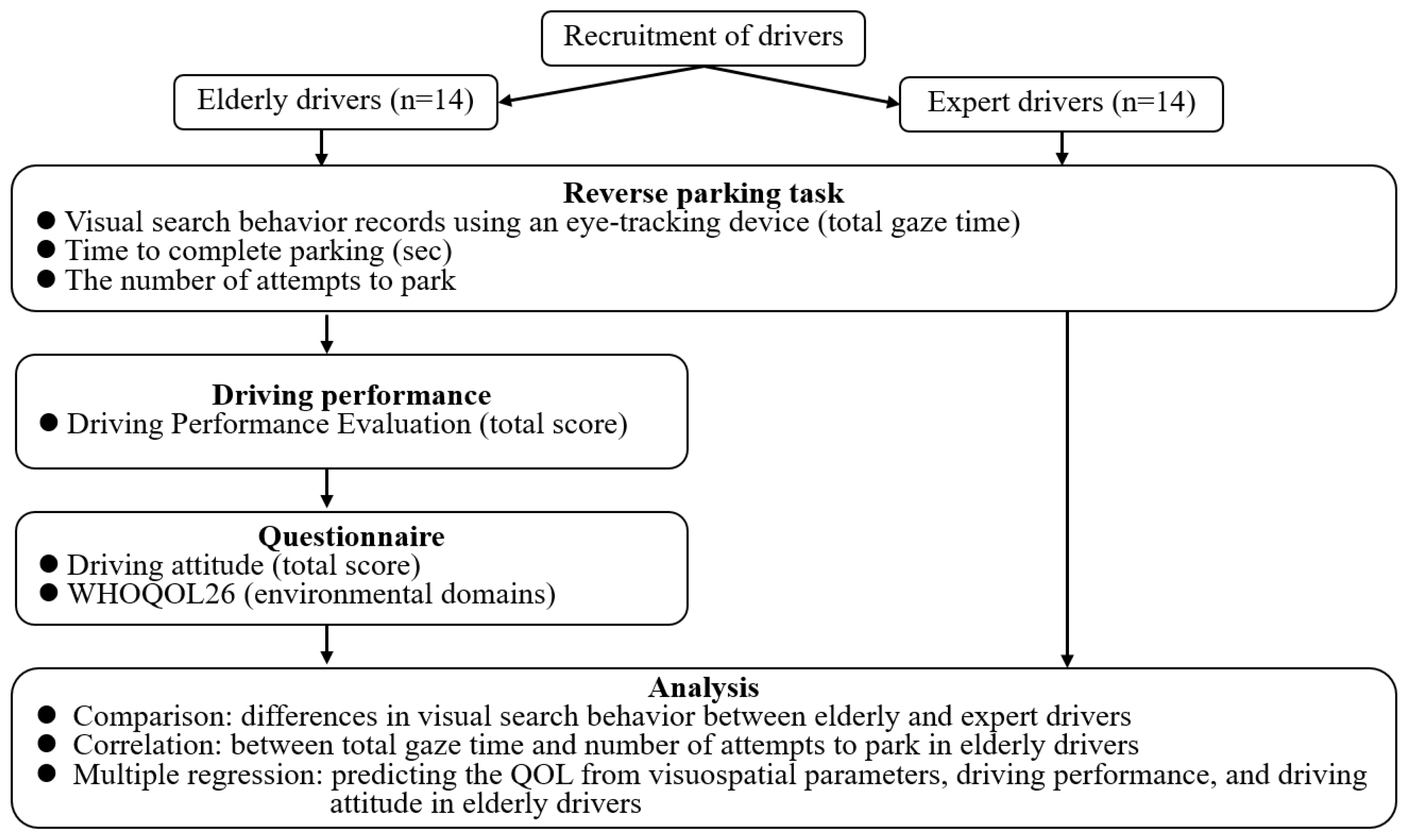

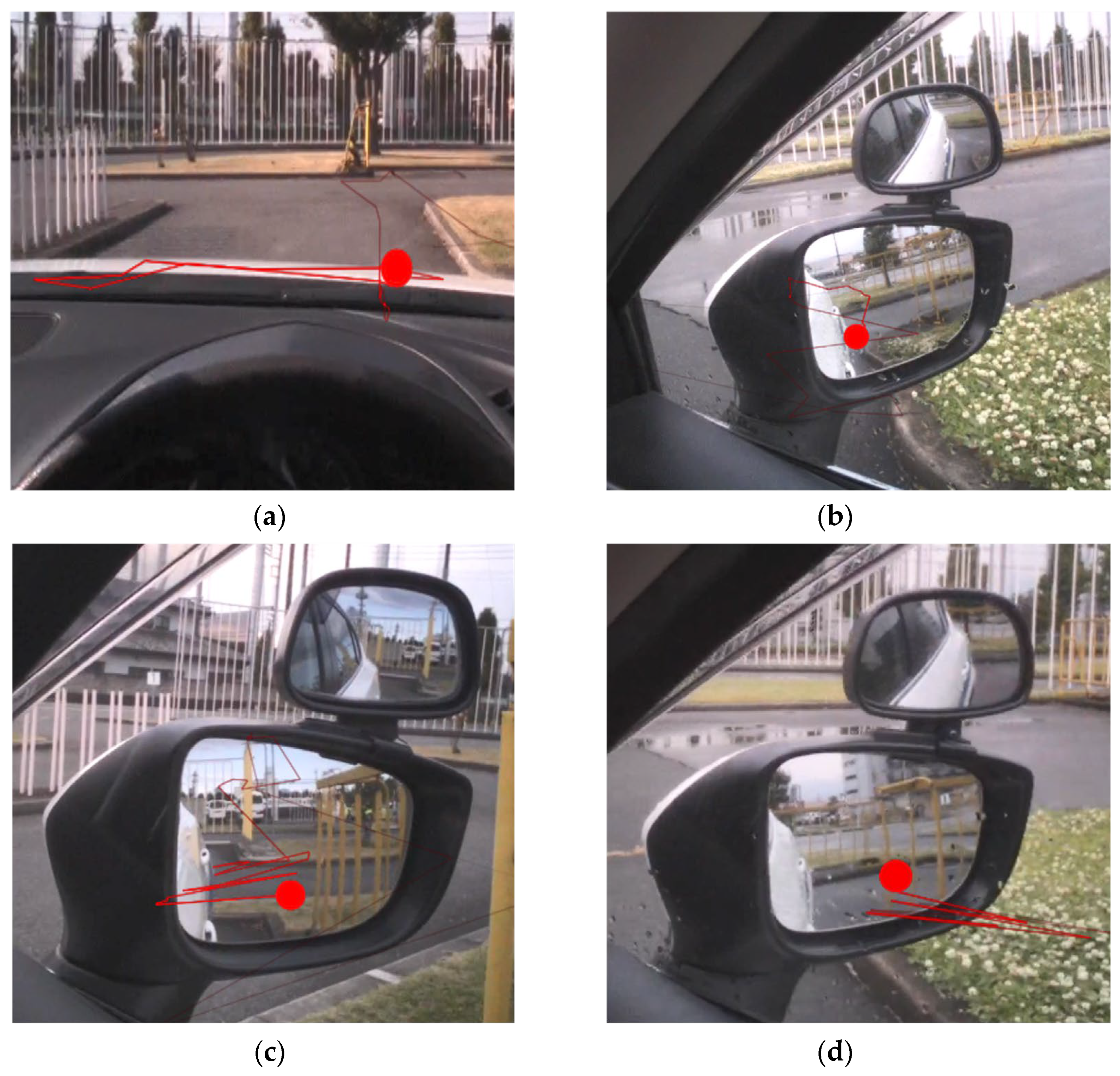

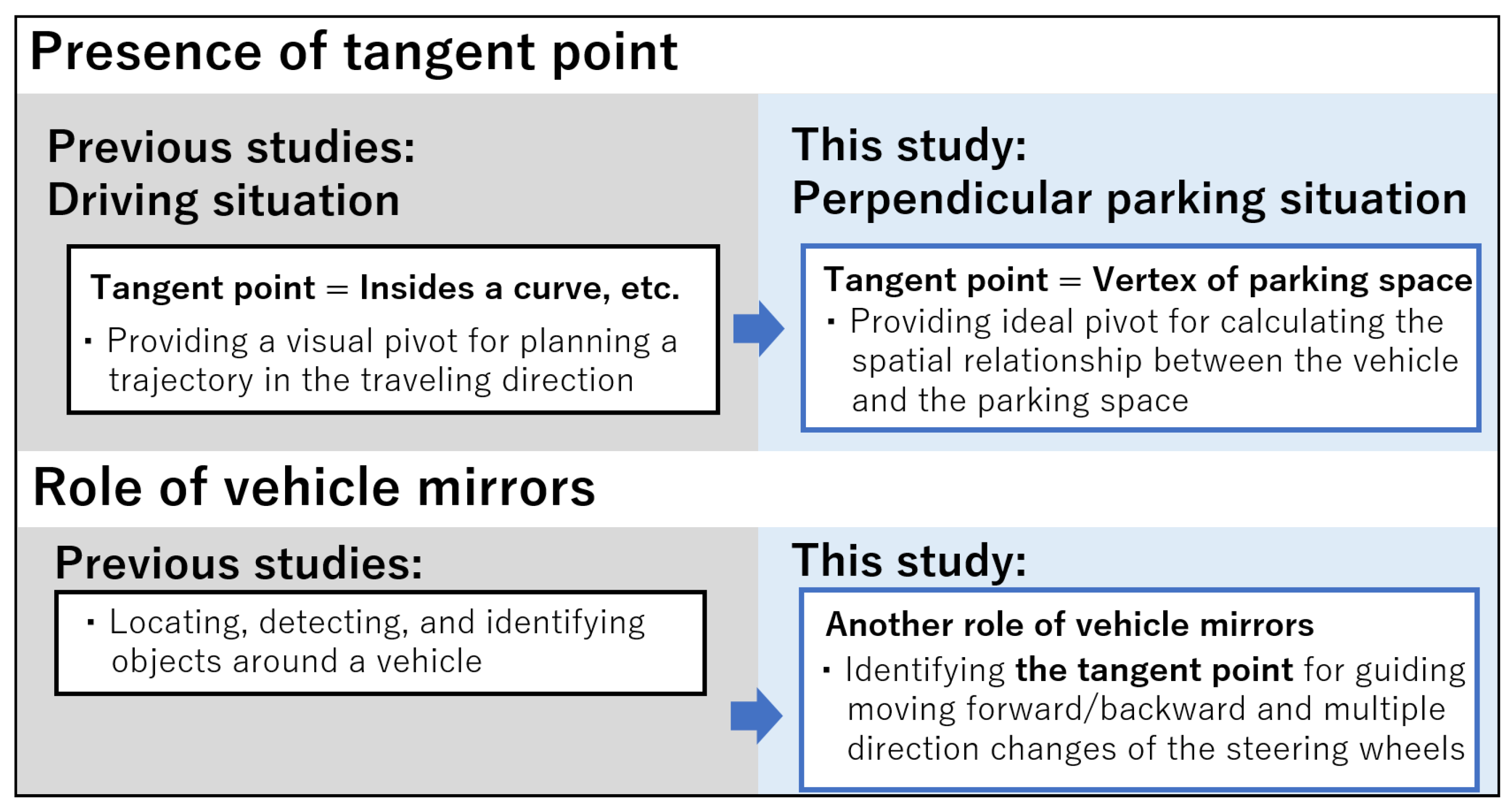
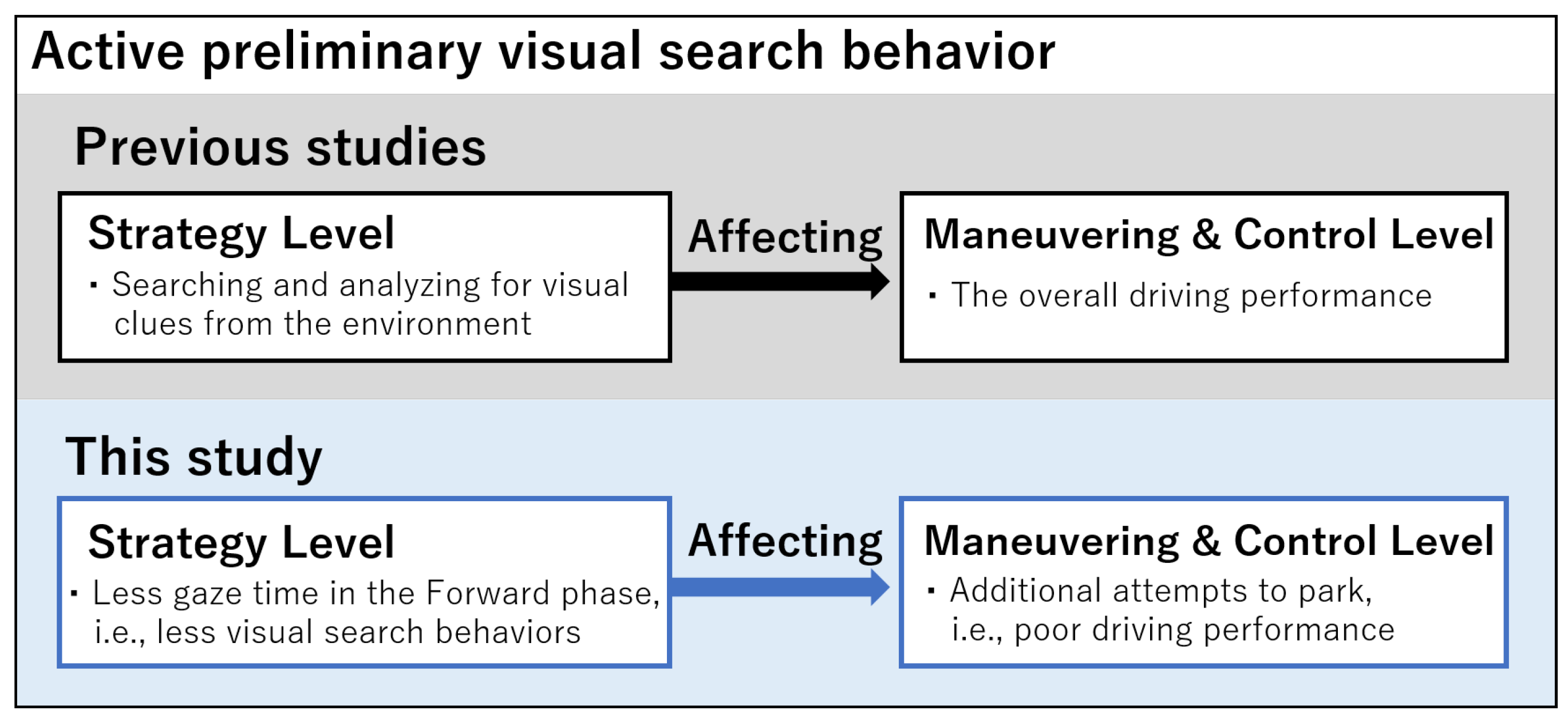
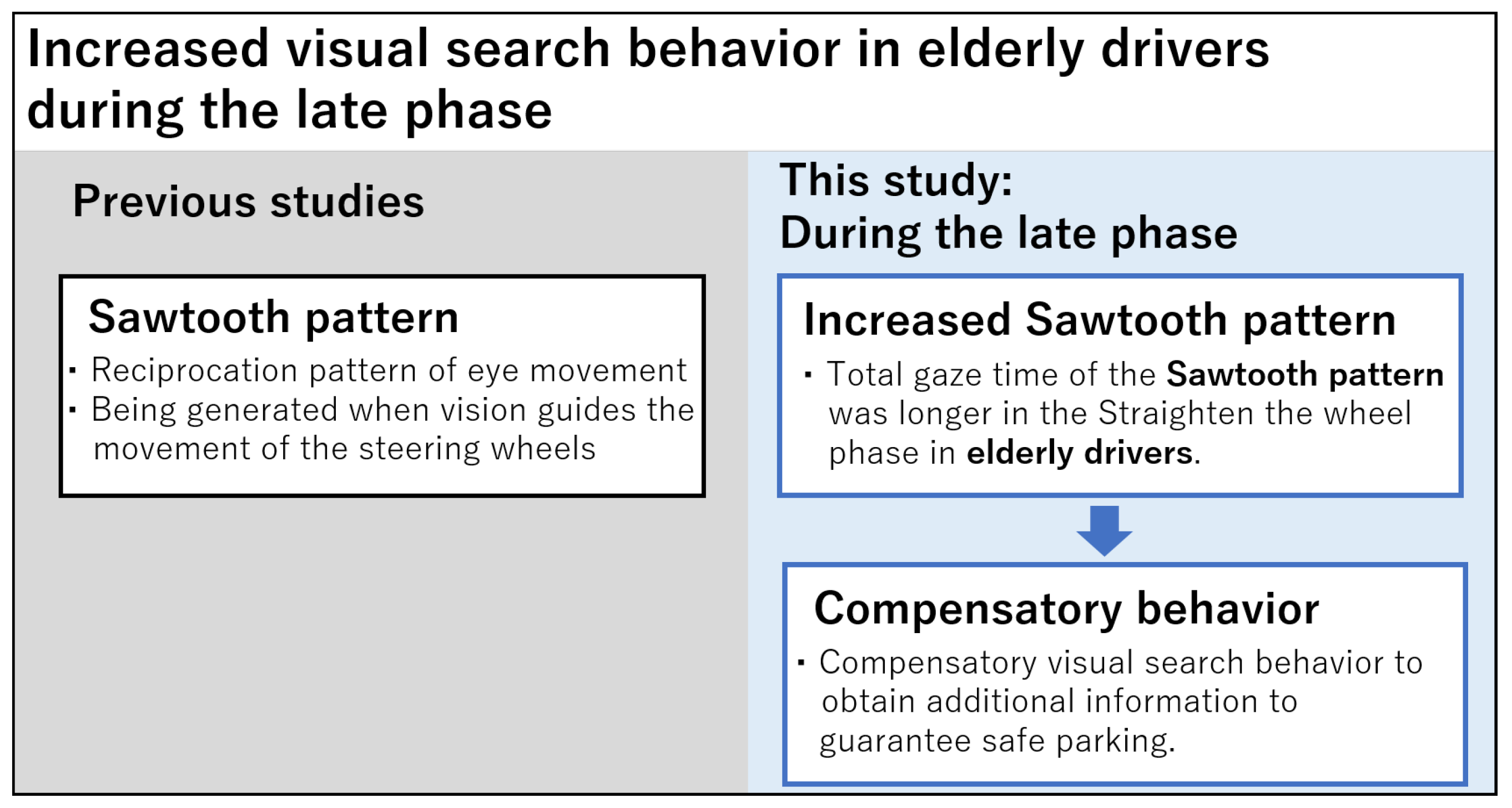
| Expert Drivers (n = 14) | Elderly Drivers (n = 14) | p | |
|---|---|---|---|
| Age | 42.1 ± 11.4 | 73.7 ± 3.4 | <0.001 |
| Gender (male/female) | 12/2 | 2/12 | <0.001 |
| BMI 1 | 23.1 ± 3.2 | 24.2 ± 3.8 | 0.53 |
| Years of education | 6.0 ± 2.0 | ||
| Years of driving license | 50.6 ± 6.7 | ||
| Years of driving instructor | 16.0 ± 9.4 | ||
| Driving attitude | 6.0 ± 0.9 | ||
| Driving performance | 18.0 ± 3.1 | ||
| WHOQOL environment 2 | 3.7 ± 0.6 |
| Expert Drivers | Elderly Drivers | p | |||
|---|---|---|---|---|---|
| Total | 11,486 ± 5114 | 9052 ± 7254 | 0.28 | ||
| Forward phase | Direct vision | Horizontal scanning | 2820 ± 1766 | 2048 ± 1868 | 0.18 |
| Vertex of the parking space | 568 ± 782 | 122 ± 228 | 0.02 | ||
| Driver-side mirror | Vertex of the parking space | 198 ± 312 | 46 ± 172 | <0.01 | |
| Reciprocating scanning | 152 ± 316 | 46 ± 126 | 0.49 | ||
| Sawtooth pattern | 508 ± 1030 | 208 ± 332 | 0.79 | ||
| Passenger-side mirror | Reciprocating scanning | 82 ± 304 | 0 ± 0 | 0.32 | |
| Sawtooth pattern | 74 ± 156 | 0 ± 0 | 0.07 | ||
| Reverse phase | Direct vision | Horizontal scanning | 830 ± 864 | 254 ± 452 | 0.02 |
| Driver-side mirror | Vertex of the parking space | 512 ± 798 | 38 ± 108 | 0.01 | |
| Reciprocating scanning | 1186 ± 898 | 288 ± 586 | <0.001 | ||
| Sawtooth pattern | 1420 ± 1736 | 1726 ± 2024 | 0.75 | ||
| Passenger-side mirror | Reciprocating scanning | 8 ± 32 | 0 ± 0 | 0.32 | |
| Sawtooth pattern | 772 ± 1066 | 2022 ± 2904 | 0.62 | ||
| Straighten the wheel phase | Direct vision | Horizontal scanning | 1280 ± 1098 | 672 ± 810 | 0.12 |
| Driver-side mirror | Vertex of the parking space | 28 ± 106 | 0 ± 0 | 0.32 | |
| Reciprocating scanning | 374 ± 622 | 198 ± 542 | 0.25 | ||
| Sawtooth pattern | 442 ± 634 | 588 ± 1026 | 0.94 | ||
| Passenger-side mirror | Reciprocating scanning | 48 ± 176 | 56 ± 182 | 0.55 | |
| Sawtooth pattern | 184 ± 558 | 742 ± 1136 | 0.04 | ||
| Time to complete parking (s) | 41.0 ± 14.8 | 72.9 ± 52.9 | <0.01 | ||
| Number of attempts to park | 1.2 ± 0.6 | 2.6 ± 2.1 | 0.01 | ||
| (millisecond) | |||||
| Number of Attempts | |
|---|---|
| Total | −0.09 |
| Forward phase | −0.56 |
| Reverse phase | −0.09 |
| Straighten the wheel phase | 0.29 |
| Dependent Variable | Adjusted R2 | Independent Variable | Standardized β | p Value |
|---|---|---|---|---|
| QOL Environment | 0.87 | Total gaze time in Straighten the wheel phase | −0.45 | 0.02 |
| Driving attitude | 0.62 | <0.01 | ||
| Driving performance | 0.58 | <0.01 |
Disclaimer/Publisher’s Note: The statements, opinions and data contained in all publications are solely those of the individual author(s) and contributor(s) and not of MDPI and/or the editor(s). MDPI and/or the editor(s) disclaim responsibility for any injury to people or property resulting from any ideas, methods, instructions or products referred to in the content. |
© 2023 by the authors. Licensee MDPI, Basel, Switzerland. This article is an open access article distributed under the terms and conditions of the Creative Commons Attribution (CC BY) license (https://creativecommons.org/licenses/by/4.0/).
Share and Cite
Kim, S.; Kondo, K.; Noguchi, N.; Akiyama, R.; Ibe, Y.; Yang, Y.; Lee, B. Decreased Visual Search Behavior in Elderly Drivers during the Early Phase of Reverse Parking, But an Increase during the Late Phase. Sensors 2023, 23, 9555. https://doi.org/10.3390/s23239555
Kim S, Kondo K, Noguchi N, Akiyama R, Ibe Y, Yang Y, Lee B. Decreased Visual Search Behavior in Elderly Drivers during the Early Phase of Reverse Parking, But an Increase during the Late Phase. Sensors. 2023; 23(23):9555. https://doi.org/10.3390/s23239555
Chicago/Turabian StyleKim, Siyeong, Ken Kondo, Naoto Noguchi, Ryoto Akiyama, Yoko Ibe, Yeongae Yang, and Bumsuk Lee. 2023. "Decreased Visual Search Behavior in Elderly Drivers during the Early Phase of Reverse Parking, But an Increase during the Late Phase" Sensors 23, no. 23: 9555. https://doi.org/10.3390/s23239555
APA StyleKim, S., Kondo, K., Noguchi, N., Akiyama, R., Ibe, Y., Yang, Y., & Lee, B. (2023). Decreased Visual Search Behavior in Elderly Drivers during the Early Phase of Reverse Parking, But an Increase during the Late Phase. Sensors, 23(23), 9555. https://doi.org/10.3390/s23239555






